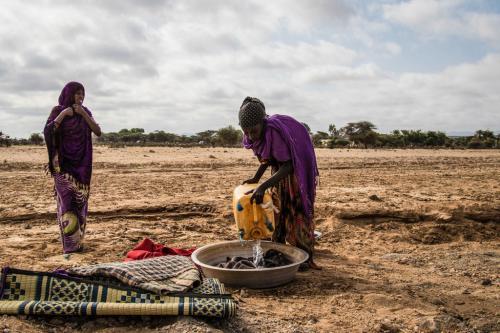Somalia: Only early action will avert another catastrophe, says senior UN relief official
Faced with a 'slight but steady' increase in the number of people in need, the humanitarian community in Somalia launched an $864 million to reach 3.9 million people with urgent life-saving assistance, the United Nations relief wing reported on Jan 17.

Worsening drought conditions have left hundreds of thousands of Somalis facing severe food and water shortages.
“Immediate support is required to prevent a significant deterioration of the humanitarian situation,” said Peter de Clercq, the Humanitarian Coordinator for Somalia.
“Given the early warning provided by the humanitarian community and the Federal Government on the drought situation, early action is the only way to demonstrate that we have learnt the lessons from the past to avert another catastrophe,” he added.
The Humanitarian Response Plan for Somalia for 2017 comes against a backdrop of deteriorating humanitarian situation in the country: expanding drought conditions have left thousands of Somalis facing severe food and water shortages. Overall, some 5 million people are in need of relief and about 3.3 million people lack access to emergency health services and require improved access to water, sanitation and hygiene.
The plight of children is particularly worrying with about 320,000 children under the age of 5 years acutely malnourished and in need of urgent nutrition support. Of these, 50,000 children are severely malnourished and far more vulnerable than any other group.
Also, around 3 million school-age children are out of school with numbers increasing and placing children at greater risk.
Furthermore, protection concerns remain high amid the humanitarian crisis with at least 1.1 million internally displaced persons and other vulnerable groups exposed to protection risks.
'Giving birth is one of the greatest risks to a Somali woman's life'
According to the Office of the Humanitarian Coordinator for Somalia, maternal mortality ratio for Somalia is among the highest in the world at 732 maternal deaths per 100,000 live births.
“Giving birth is one of the greatest risks to a Somali woman's life,” it said, adding that the Plan seeks to strengthen emergency response preparedness measures, in collaboration with the country's authorities, to mitigate the impact of predictable shocks and continue to build stronger linkages between life-saving and development-based durable solutions.
“Enhancing communities' ability to cope with shocks through the long-term sustainable livelihood support and basic services, including durable solutions, in a community-based approach, will be vital in addressing underlying causes of vulnerabilities,” it noted.
Source:United Nations
- 247 reads
Human Rights
Ringing FOWPAL’s Peace Bell for the World:Nobel Peace Prize Laureates’ Visions and Actions

Protecting the World’s Cultural Diversity for a Sustainable Future

The Peace Bell Resonates at the 27th Eurasian Economic Summit

Declaration of World Day of the Power of Hope Endorsed by People in 158 Nations

Puppet Show I International Friendship Day 2020

